Cleveland Peter Peltier and Mabel Caroline Erhardt (part 1)
There were already 5 children in the family by the time Cleveland Peter (Cleve), my granduncle, was born on May 29, 1895 on the family farm in White Bear Township.1 At the time of his birth, his mother Celestine was 26 years old, his father Albert was 35 years old, his sisters, Alice, Ellen and Mary Rose (Vina) were respectively 9 years old, 6 years old and 4 years old and his brothers Albert Noah (Bert) and Edmund were respectively 7 years old and 11 months old.
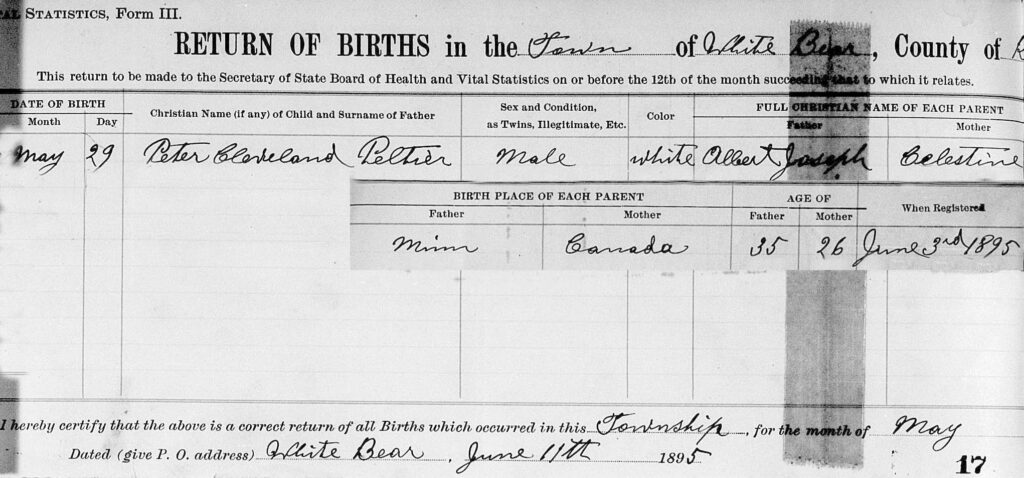
Cleve was baptized 4 days after his birth, on June 2, 1895, at the Church of St. John the Evangelist in Little Canada.2 The baptism was performed by Father Joseph Goiffon, the officiate at many family baptisms and marriages. Cleve’s godparents were John Peter Flandraks [Flandrick] and Bertha Moricette [Morrisette]. Bertha, John Peter Flandrick’s wife, was Cleve’s first cousin once removed (my first cousin 3 times removed).

Cleve is enumerated with his family in the 1900 U. S. census which includes another sibling, Norma Genevieve (she is enumerated as a male called Norman on the census record).3 Cleve’s paternal grandfather Charles Peltier and his uncle Leon Peltier are listed as residents on the same property. Charles and Leon are residing in the first home on Charles’ property and Albert’s family is in the second home that was built.
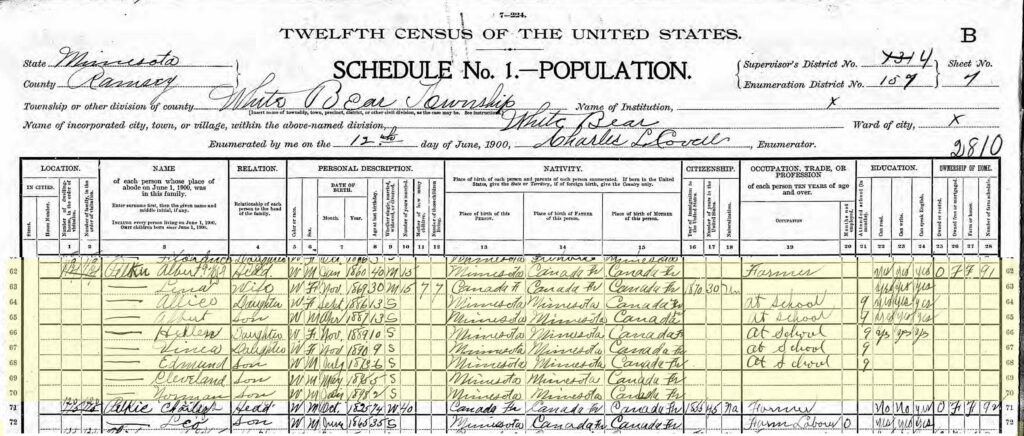
By the time the 1905 Minnesota census was taken, 2 more siblings were added to the family, of which only one survived, Frances Mary; the other, Eveline, had lived only 12 days.4 Cleve, Norma, Edmund and Vina are shown as attending school while the rest are working on the farm or elsewhere.5


By the 1910 U. S. census 3 more siblings had been born: Edgar Joseph who lived only 14 months, Roy Henry and Avis. 6, 7 The census enumerates 7 of the 10 surviving siblings, including 15 year old Peter C. [Cleve]; he is actually 14 years old at the time of the census. There is no occupation shown for Cleve, but I assume that he works on the family farm. His 3 older sisters have left home: Alice and Ellen are married, while Vina is working as a servant in a home in White Bear.8

In 1912 one more sibling, Clement John (Clem), joined the family.9 Cleve had become “the middle child” with 5 surviving siblings older than him and 5 surviving siblings younger than him.
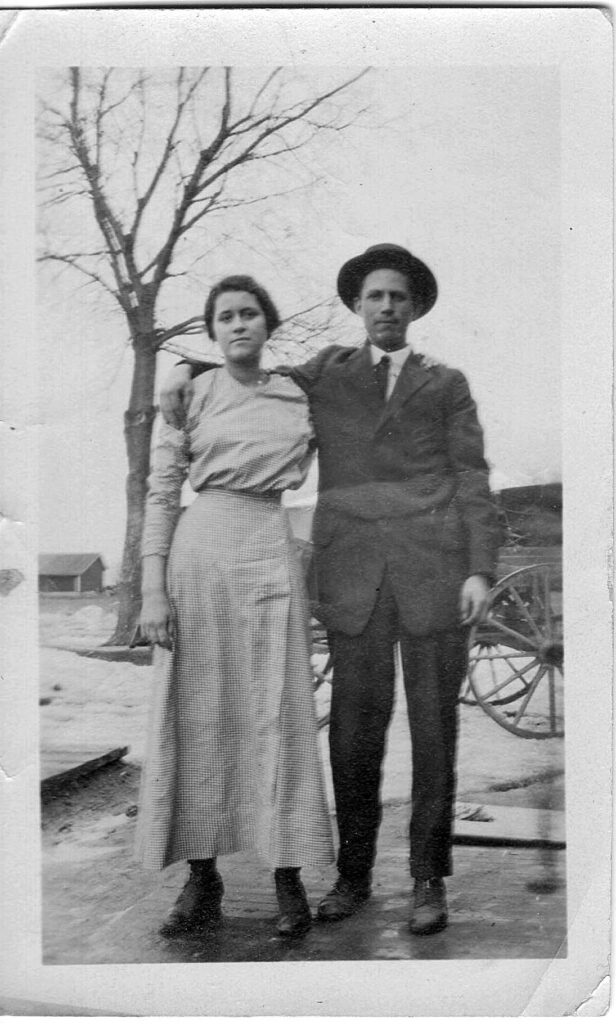
Cleve, like many other young men his age, would be called into service during the Great War, World War I. He registered for the draft on June 5, 1917 and enlisted in the U. S. Army on February 24, 1918.10, 11 At the time of his draft registration he was farming for Judge E. W. Bazille on a farm in White Bear Township.


Cleve’s service during the war was with Company B, 56th Engineers (Searchlight), American Expeditionary Forces (A.E.F.). Before the Great War, searchlights had been developed by the United States Army to use for coast defense and battle illumination.
The following details Cleve’s service with the 56th Engineers. Much of the text can be found in the public domain book “The 56th Engineers in the World War.”12
After training at Washington Barracks, on May 10, 1918 Company B, along with Company D and Detachment Company C, set sail from Hoboken, New Jersey aboard the U.S.S. Wilhelmina; the troops arrived in Brest, France on May 23rd.13

Orders were to proceed to Fort du Mont Valerien, where they arrived May 30th. At this station the Company was divided into five Platoons, the 10th, 11th, 12th, 14th and 15th; Cleve was assigned to the 14th Platoon. These Platoons were detailed for duty with the French Anti-Aircraft Artillery with the following two months being spent in intensive training, as the enemy bombing activity was moderate.
After the formation of the First American Army, the Company proceeded by trucks on September 3rd to Colombey-les-Belles, arriving there September 7th for Anti- Aircraft duty with the first Army. Headquarters were established on September 8th at Royaumeix and searchlights were placed in positions about six kilometers in back of the lines in a double row paralleling the front. The lights were moved forward after the St. Mihiel attack, occupying positions extending from Hondicourt to Lironville, and Company Headquarters moved to Hamonville. There was a large amount of bombing activity during favorable weather and much success was attained in the illumination of enemy planes.
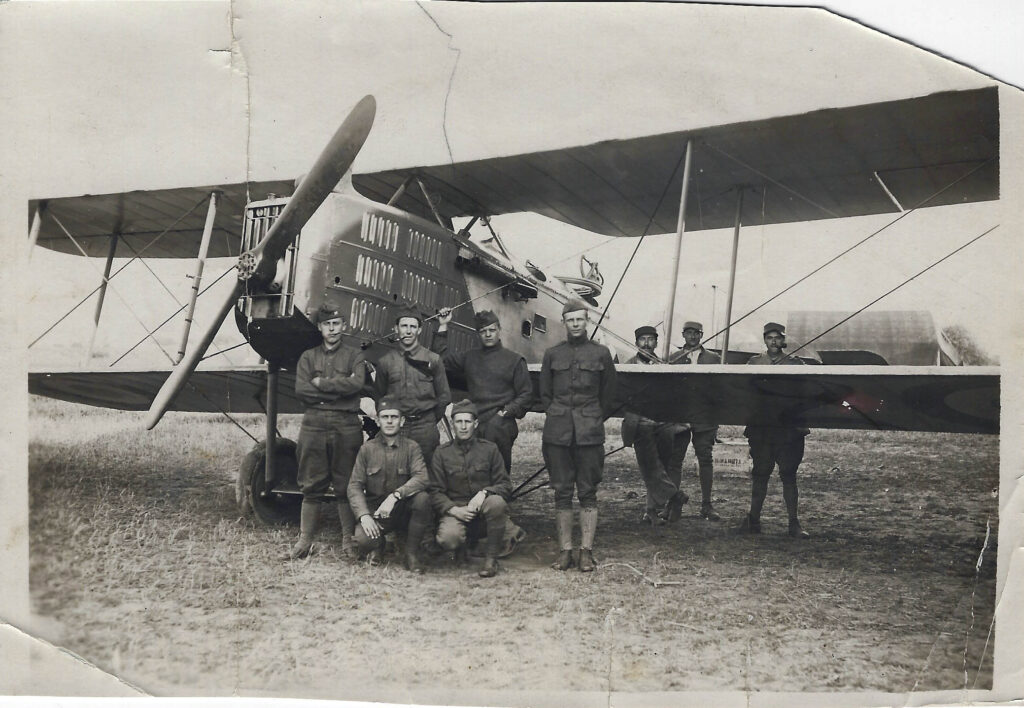
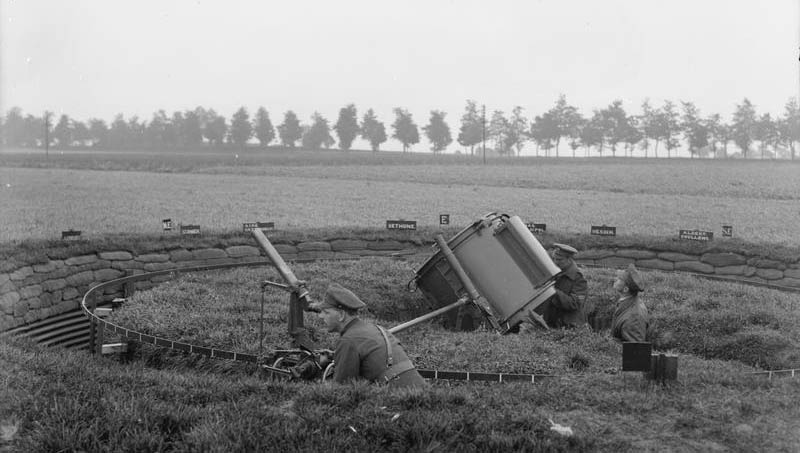
On September 24th new positions were occupied along the Meuse, headquarters being established at Tilly-sur-Meuse, but four days later moved to Fort de Genicourt. The positions occupied extended along the Meuse for a distance of about twelve miles, about half of which was in the First Army Area and the remainder in the Second. There was a moderate amount of air activity and all enemy planes that approached were obliged to turn back or circle around the southern flank of the lights. It was largely due to care in construction and proper use of cover that the casualties were very few, there being a considerable amount of shell fire by enemy artillery and bombing and machine gun fire from hostile air craft.
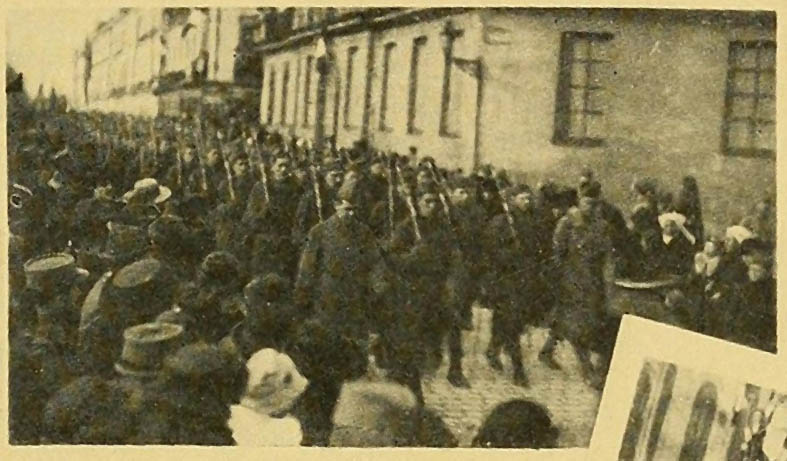
On April 1st Company B moved to St. Nazaire. Cleve was on board the USS Rijndam (originally a Dutch passenger liner that was seized by the U. S. government) when it set sail from St. Nazaire, France on April 13, 1919.14 The ship arrived at Newport News, Virginia on April 25, 1919. The Company then went to Camp Lee, Virginia where demobilization occurred; Cleve was discharged on May 13, 1919, having served almost 14 months.
On November 19th a move was made to Conflans, engaging in the construction of telephone lines for the railway system centering at Conflans and extending to Arlon, Didenhofen, Metz and Etain. They were relieved from that duty on December 6th and proceeded to Dampierre, arriving there December 8th, for preparation for return to the United States.

Cleve, 24 years old and a veteran, is enumerated in the 1920 U. S. census as a lodger in a St. Paul boarding house; he is working as a farm laborer.15 His older brother Albert Noah (Bert) is also listed as living in the same boarding house doing the same work. Maybe there wasn’t room for them to live on the farm, but they were still working the land with their father? At the same time, they are both listed in the 1920 St. Paul City Directory as living at 633 Wabasha, which I assume is the address of the boarding house, but they are shown as working as molders (maybe at a foundry) and not as farm laborers.16
Mabel Caroline Erhardt, Cleve’s future wife, was born on December 20, 1902 in Oneka Township, Washington County, Minnesota.17 At the time of her birth, her father Louis, a farmer, was 51 years old and her mother Mary C. (Nelson) was 41 years old. Mabel was the 9th child born to the couple.
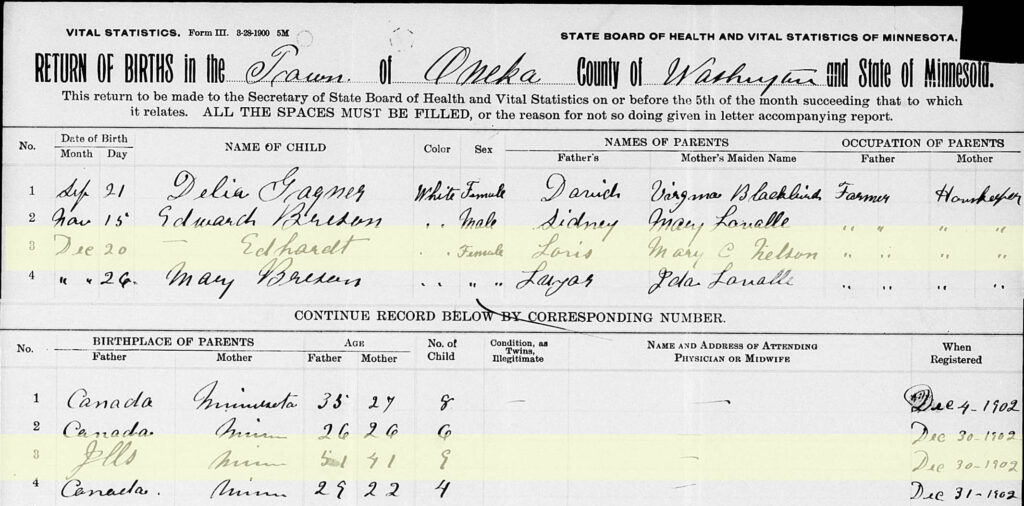
The 1920 U. S. census enumerates Mabel as still living with family members in Oneka Township, but by 1921 she is listed in the St. Paul City directory as a boarder at 612 Central Park Place (an area near the Capitol building that is now gone) and working as a stitcher at the O’Donnell Shoe Company.18, 19
So how did Cleve and Mabel meet? Maybe they met in St. Paul. In 1920, the location where Cleve lived was near an open space called Central Park near where Mabel lived. I imagine young people would gather there in the evening and on weekends to socialize (the dating app of the 1920s).
By 1922 neither Cleve or Mabel are listed in the St. Paul City directory.20
The 1930 U. S. census enumerates Mabel in her sister Gertrude St. Sauver’s household in White Bear Lake.21 Mabel, Gertrude and Gertrude’s daughter Myrtle all work as telephone operators at the Tri-State Telephone Exchange in White Bear Lake. The same census shows Cleve as working as a conductor for the City Railroad (Twin City Rapid Transit Company) and living in St. Paul.22 The 1930 St. Paul City directory gives his address as 1027 Case.23
Somewhere and somehow the couple met, and on September 13, 1930 Cleve and Mabel were married at St. John’s Church in Little Canada, he was 35 years old and she was 27 years old.24

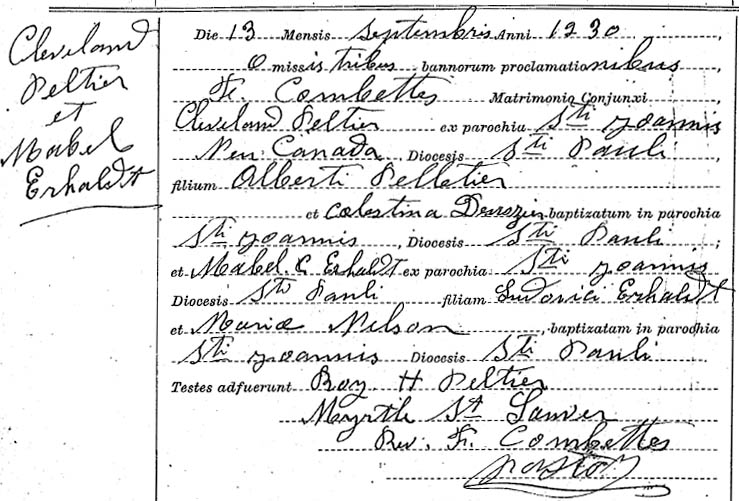


To be continued…
Thanks for visiting, come back soon,
Cynthia
© 2024 Copyright by Cynthia Vadnais, All Rights Reserved
Footnotes for Cleveland Peter Peltier and Mabel Caroline Erhardt post
Cleveland Peter Peltier and Mabel Caroline Erhardt (part 1) Read More »
